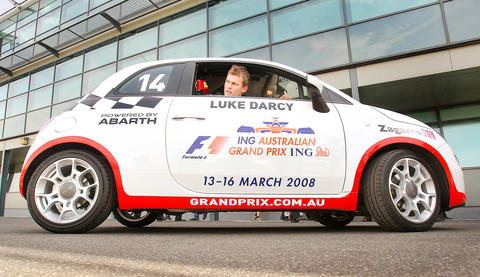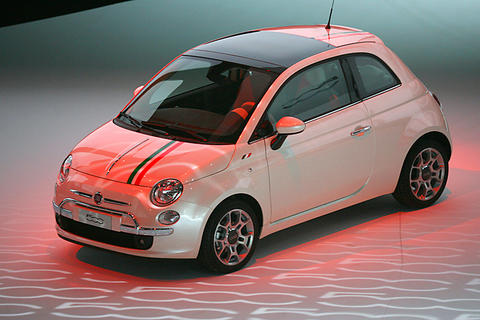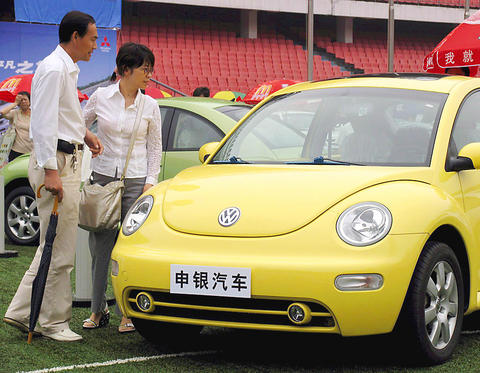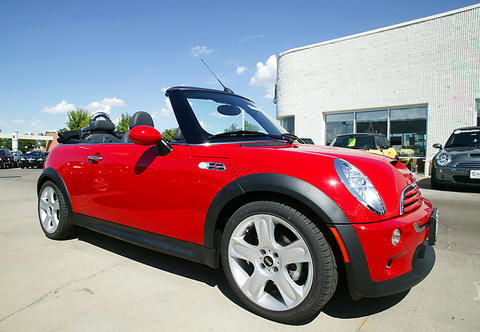The Fiat 500 is European Car of the Year 2008, and little wonder. It is smart, sassy and, for what is basically a small, soft blob of metal, enormously covetable. But it is also, essentially, half a century old. The first 500 rolled out of Italian factories in 1957 - a comically diminutive, rear-engined buzz-about, generally regarded as the first ever "city car." By the time production ceased in 1975, the "Cinquecento" was looking tired, flat and, in the world of battleships like the Ford Granada, increasingly likely to get run over. For a good 40 years, the 500 was destined to have a limited appeal beyond enthusiasts and people with a strong sense of irony.
Yet somehow Fiat's new but immediately recognizable revival of this wasp among cars has just won the European motor industry's most coveted recommendation. Actually, it didn't just win it - it romped home. Of the 58 motoring journalists from around Europe whose votes decide the Car of the Year Award, 57 writers had the 500 on their shortlist, and 33 put it top of their personal ranking.
Enthusiasm among buyers appears to be equally demonstrative. The car was launched in July in Italy and France, and 105,000 orders were taken in four months. It seems likely that the new Fiat 500 will, not long into 2008, attain the ubiquity on the UK's roads of that other revived classic, the BMW Mini .

PHOTO: AFP
Of course, there will be one or two differences between the new 500 and the old models. The original, meager but willing 479cc air-cooled engine - essentially two hair-dryers gaffer-taped together - has been replaced by front-mounted engines in more generous sizes, from 1.2 liters upwards, so the chances are the new 500 won't sound like someone blowing a raspberry down a mailing tube. Also, it will be fitted out with the comforts that we have to come to take for granted in even the most modest cars: electric windows, remote locking, probably even compatibility for an MP3 player. And it will be fatter all round than the original 500, making it far harder to reverse it into the gaps between other parked cars in such a manner that the bumpers end up parallel with the pavement (standard practice with an old "Cinquecento" in Rome, among other places).
Nevertheless, it is clear that, as with the revived Mini, and the retro VW Beetle before it, the passion is again out there for a new car that is significantly an old car. And at the same time, after more than a decade in which people-carriers and sports utility vehicles have bulked ever larger, there seems to be an increasing will now to reappraise the virtues of going small and nippy - and perhaps even a will to discover the folksy joy of driving with one's shoulders hunched and one's knees in one's ears.
The Mini, of course, has been able to trade easily on its firmly embedded cultural and counter-cultural associations. So, to a lesser extent, has the revived Beetle, with its dash-mounted vase and ditzy silk flower. But the Fiat 500 has some powerful 1960s cachet, too. Indeed, legend has it that it would have had that era-defining role in The Italian Job if the Mini hadn't come along at just the right moment and stolen the part from under the 500's front bumper.

PHOTO: AFP
People of a certain age will bring their own memories to the new 500 - which could go either way, of course. As a teenager, I spent time in a Fiat 500 whose bodywork had been decorated with large, colored spots, making it look like something from the downward curve of a particularly nasty mushroom trip. To be a passenger in this car was not unlike being pushed down the street in a supermarket trolley, except that you were significantly deafer and twice as bewildered when you eventually got out.
But gone now are the days when a new car could be named after a wind or a high-end holiday resort and come bristling with fins and ridges and jagged chrome add-ons. Typically, the modern small car appears to take its name from software or personal electronics and resembles a sucked boiled sweet. It meets some of our time's resistance to the very idea of cars halfway. If not exactly in denial, it is, at least, apologetic about being a car, less overtly purposeful in its shape and ready-to-use cuteness, in the form of a pair of Bambi-esque dish-sized headlamps, as a diversionary tactic. Cars such as the Fiat 500, the Mini, the Nissan Micra, the Toyota Yaris and the Hyundai i30 look so innocent, you are surprised they drink gas at all, rather than, say, fruit juice, mixed with the occasional Jelly Tot.
The new 500 also presses all the hot-button contemporary motoring issues: consumption, emissions, congestion. It sips gas, guffs out a relatively small amount of carbon dioxide, and takes up little space. Whisper the fact that, for many buyers, a 500 will be a second car, the need for which may be highly questionable and not easily rationalized on the basis of the car's frugal economy figures. The point is, the original 500 was the product of a postwar economy - a budget motor made for a world in which resources were thin on the ground - so perhaps it shouldn't surprise us to find its shape and ethos re-appealing in an age when questions about limited resources again apply.

PHOTO: EPA
But the Fiat 500 has history on its side, too. It fondly harks back, however deceptively, to a time when driving was a more innocent thing to get up to, when the road ahead to the corner shop lay more open and when the notion that the world might be frying in its own fat was not one that routinely needed to burden a car owner's conscience. No wonder people across Europe are jumping in.

PHOTO: AP

Nine Taiwanese nervously stand on an observation platform at Tokyo’s Haneda International Airport. It’s 9:20am on March 27, 1968, and they are awaiting the arrival of Liu Wen-ching (柳文卿), who is about to be deported back to Taiwan where he faces possible execution for his independence activities. As he is removed from a minibus, a tenth activist, Dai Tian-chao (戴天昭), jumps out of his hiding place and attacks the immigration officials — the nine other activists in tow — while urging Liu to make a run for it. But he’s pinned to the ground. Amid the commotion, Liu tries to

The slashing of the government’s proposed budget by the two China-aligned parties in the legislature, the Chinese Nationalist Party (KMT) and Taiwan People’s Party (TPP), has apparently resulted in blowback from the US. On the recent junket to US President Donald Trump’s inauguration, KMT legislators reported that they were confronted by US officials and congressmen angered at the cuts to the defense budget. The United Daily News (UDN), the longtime KMT party paper, now KMT-aligned media, responded to US anger by blaming the foreign media. Its regular column, the Cold Eye Collection (冷眼集), attacked the international media last month in

A pig’s head sits atop a shelf, tufts of blonde hair sprouting from its taut scalp. Opposite, its chalky, wrinkled heart glows red in a bubbling vat of liquid, locks of thick dark hair and teeth scattered below. A giant screen shows the pig draped in a hospital gown. Is it dead? A surgeon inserts human teeth implants, then hair implants — beautifying the horrifyingly human-like animal. Chang Chen-shen (張辰申) calls Incarnation Project: Deviation Lovers “a satirical self-criticism, a critique on the fact that throughout our lives we’ve been instilled with ideas and things that don’t belong to us.” Chang

Feb. 10 to Feb. 16 More than three decades after penning the iconic High Green Mountains (高山青), a frail Teng Yu-ping (鄧禹平) finally visited the verdant peaks and blue streams of Alishan described in the lyrics. Often mistaken as an indigenous folk song, it was actually created in 1949 by Chinese filmmakers while shooting a scene for the movie Happenings in Alishan (阿里山風雲) in Taipei’s Beitou District (北投), recounts director Chang Ying (張英) in the 1999 book, Chang Ying’s Contributions to Taiwanese Cinema and Theater (打鑼三響包得行: 張英對台灣影劇的貢獻). The team was meant to return to China after filming, but